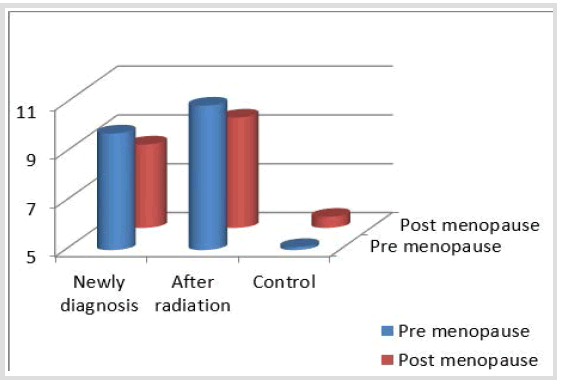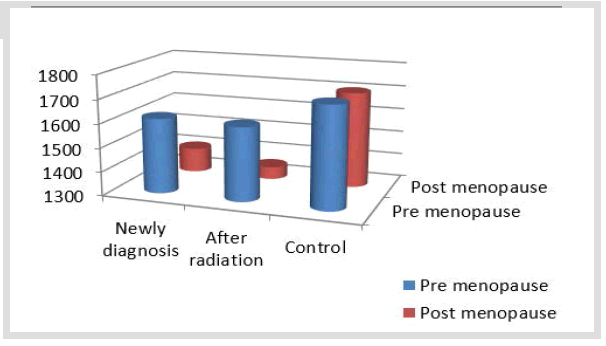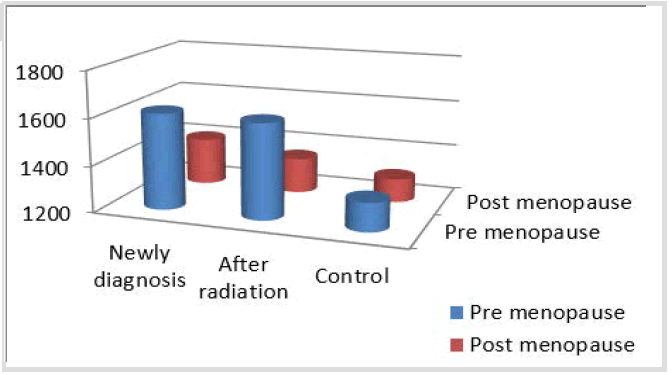Research Article - Onkologia i Radioterapia ( 2023) Volume 17, Issue 7
Assessment of serum levels of ESR1 and EGFR2 and human vitamin D3 as potential novel biomarkers in breast cancer patients
Abdalnaser K. A. Al-Zuhayri* and Firas Faris RijaAbdalnaser K. A. Al-Zuhayri, Department of Biology, College of Science, University of Tikrit, Tikrit, Iraq, Tel: 009647705896208, Email: abdalnaser.k.ahmed.bio2022230@st.tu.edu.
Received: 15-Mar-2023, Manuscript No. OAR-22-91722; Accepted: 16-Jul-2023, Pre QC No. OAR-22-91722 (PQ); Editor assigned: 27-Mar-2023, Pre QC No. OAR-22-91722 (PQ); Reviewed: 30-Apr-2023, QC No. OAR-22-91722 (Q); Revised: 17-Jun-2023, Manuscript No. OAR-22-91722 (R); Published: 20-Jul-2023
Abstract
Background: Breast cancer is the most prevalent kind of cancer worldwide and the main reason why people die from cancer. Represents 18% of all malignancies in women. and second most common type of cancer after lung cancer.
Objective: In this study, ESR1, EGFR2 and human vitamin D3 were investigated in Iraqi women breast cancer patients.
Patients and methods: In this study, serum concentrations of ESR1, EGFR2 and HUMAN VITAMIN D3 were determined using samples from 90 Iraqi women (60 patients and 30 healthy volunteers) Among them are healthy and patients, premenopausal and postmenopausal woman.
Results: According to the findings of the current study, ESR1, EGFR2 and were both considerably elevated in breast cancer patients (P<0.05), and they also had a tight relationship, and human vitaminD3 was a decrease in patients with breast cancer on the probability level (P<0.05).
Conclusions: This research discovered a link between high serum levels of ESR1, EGFR2, and its inverse relationship with vitamin D.
Keywords
Breast cancer, ESR1 , EGFR2 and human vitamin D3
Introduction
Breast cancer is the most common type of cancer worldwide and the leading cause of death from cancer, accounting for 18% of all malignancies in women. and after lung cancer, the second most common type of cancer and the fifth among malignancies that cause death worldwide, and despite the development of detection and treatment methods for breast cancer, which has resulted in a decrease in the death rate in developed countries, there is an increase in the disease's incidence and resulting deaths in middle and low-income countries [1,2]. According to the American Cancer Society's estimates for breast cancer in the United States through 2022, breast cancer primarily affects middle-aged and older women. Both modifiable and immutable risk factors for BC make up a sizable portion of the total risk factors. Nowadays, people over 50 make up roughly 80% of BC patients. Stage and molecular subtype affect survival and Fewer than 5% of breast cancer patients are under the age of 45 [3,4]. Breast cancer primarily affects women, not males, and is thought to be owing to the larger tissue mass in women compared to men [5].
The acquisition of splicing-independent ESR1 mutations during treatment with aromatase inhibitors in Estrogen Receptor (ER)- positive breast cancer is a common mechanism of resistance to hormonal therapy. Preclinical and clinical studies have shown that ESR1 mutations can be pre- existing in primary tumors and can be enriched during metastasis. Furthermore, ESR1 mutants express a unique transcriptional profile that favors tumor progression, suggesting that specific ESR1 mutations may affect metastasis [6].
In the other way, some proteins in breast cancer play a central role in the pathogenesis of several human cancers. However, about 15% to 20% of invasive breast cancers have higher levels of a protein known as HER2. These cancers are called HER2- positive breast cancers. HER2 is a protein that helps breast cancer cells grow quickly. HER2 activation induces uncontrolled proliferation, protects against apoptosis, and disrupts normal epithelial organization in epithelial cells [7]. Moreover, different groups investigated if VDR expression could be used as a potential biomarker for cancer progression and survival [8, 9, 10]. According to studies, risk factors of breast cancer may differ depending on the subtype of breast cancer. And the prognosis of triple negative breast cancers (ER-, PR-, and HER2-negative) is worse than that of hormone receptor positive or luminal tumors [11].
Material and Methods
Ninety women were involved in the study, 60 of them were breast cancer patients who visited Al-Amal National Hospital for Cancer Treatment in Baghdad, and the remaining 30 were female volunteers who seemed to be in good health and They were divided into two groups, the premenopausal group and the postmenopausal group.
Ethical consent
Written informed consent was obtained from each patient to participate in the current study. The Central Scientific Research Ethics Committee at Tikrit University approved this research.
Inclusion criteria
Patients with malignant or invasive breast tumors who were newly diagnosed with breast cancer prior to partial mastectomy or mastectomy and who did not receive any type of cancer treatment such as chemotherapy or radiotherapy before and after menopause, as well as patients who received radiation therapy before and after menopause, as well as control women before and after menopause, and patients who agreed to participate in this study
Exclusion criteria
Cases involving other types of cancer, such as colon, rectum, stomach, brain, lung, and others, in which consent was not obtained.
Sampling
The study's patients provided 5 milliliters of blood, which was drawn, put in gel tubes, allowed to clot for 20 minutes, and then centrifuged for 15 minutes at a speed of 4,000 revolutions per minute to extract serum. Following the storage of the serum in three Eppendorf tubes in a deep freezer at 20°C, samples were once more warmed to room temperature before these assays were carried out.
Evaluation of ESR1, EGFR2 and HUMAN VITAMIN D3 serum concentrations
Commercial kits were used to evaluate the concentrations of ESR-1, EGFR-2 and human vitamin D3 using Enzyme-Linked Immunosorbent Assay technique
Study enrollment procedures
For each case, detailed information was recorded, such as age, gender, the duration of the injury for breast cancer, determine chemotherapy, radiotherapy, or primary injury, and others. The presence of breast cancer was confirmed through the patients' medical histories and the tests they underwent, such as imaging and tissue biopsy [12].
Statistical analysis
The minitab program was used to perform a statistical analysis of the results using the analysis of variance (ANOVA) test. Under the probability level of 0.05, the arithmetic means were compared to Duncan's multiple ranges test [13,14].
Results
Figure 1 and Table 1 showed an intermediate increasing in serum level of ESR1, in newly diagnosed women before menopause and simple increase after menopause compared to the rest of the groups at the level of probability) P<0.05) in the women patients with breast cancer.
Figure 1: Fig. 1. Assessment Serum ESR1 (pg/ml) in studied groupsd
Tab. 1. Concentration of serum ESR1, EGFR2 and HUMAN VITAMIN D3 in Women with breast cancer compared to healthy women subject
| No. of individual | group | ESR1 | EGFR2 | HUMAN VITAMIN D3 |
|---|---|---|---|---|
| Newly diagnosis females | Pre menopause | 1613±57.8% a |
9.780±4.08% a |
1613±57.8% c |
| Post menopause | 1403±42.9% a |
8.417±2.42% ab |
1403±42.9% d |
|
| After radiation | Pre menopause | 1607±57.1% a |
10.920±2.51% a |
1607±38.1% bc |
| Post menopause | 1352±41.8% a |
9.520±4.40% a |
1352±41.8% d |
|
| Control | Pre menopause | 1322±40.6% c |
5.125±1.12% b |
1722±65.1% a |
| Post menopause | 1301±39.1% c |
5.455±1.45% b |
1701±60.6% ab |
|
| P-value | *0.053 | *0.035 | *0.045 |
The results of the current study also showed, as shown in (Figure 2) and (Table 1), there is a high increase in serum level of EGFR2 and there is the existence of statistical differences between groups at the level of probability (P<0.05). in the blood serum of breast cancer patients of the premenopausal age group and the postmenopausal age

Figure 2: Assessment Serum EGFR2 (ng/L) in studied groups
Also, the present study showed as shown in (Figure 3) and (Table 1) that there was significant decrease in serum level of human vitamin D3 in the postmenopausal woman and approximate decrease in the premenopausal woman compared with the control samples and there were statistical differences between groups at the level of probability (P <0.05) in the serum of breast cancer patients of the age group before menopause and the age group after menopause.

Figure 3: Assessment Serum Human Vitamin D3 (pg/ml) in studied groups
Discussion
The results of the current study agree with the findings of that postmenopausal diseases is more prevalent compared to premenopausal patients [15].
The current study's findings were consistent with those of, who indicated that there was an increase in the level of (ESR1) in newly diagnoses woman Estrogen receptor alpha (ERα), also known as NR3A1 (nuclear receptor subfamily 3, group A, member 1), is one of two main types of estrogen receptor, a nuclear receptor (mainly found as a chromatin-binding protein) that is activated by the sex hormone estrogen. In humans, ERα is encoded by the gene ESR1 (Estrogen Receptor 1). Estrogen receptor (ER)- positive breast cancer accounts for 70%–80% of all diagnosed breast cancers. Estrogen is a steroid hormone that has critical roles in reproductive development, bone homeostasis, cardiovascular remodeling and brain functions [16].
However, estrogen also promotes mammary, ovarian and endometrial tumorgenesis. Estrogen antagonists and drugs that reduce estrogen biosynthesis have become highly successful therapeutic agents for breast cancer patients. The effects of estrogen are largely mediated by estrogen receptor (ER) α and ERβ, which are members of the nuclear receptor superfamily of transcription factors [17].
And the results of the current study agreed with the findings, who indicated that there was an increase in the level of (epidermal growth factor receptor 2) Overexpression of HER2 (which derives its name from human epidermal growth factor receptor 2) is the primary pathway of HER2 receptor overexpression and is a major driver of tumour development and progression in a subset of breast cancers. The human epidermal growth factor receptor (HER) family of receptors plays a central role in the pathogenesis of several human cancers. They regulate cell growth, survival, and differentiation via multiple signal transduction pathways and participate in cellular proliferation and differentiation [18].
Also, the results of the current study agreed with the findings, who indicated that there was an decrease in the level of vitamin D in patients with breast cancer , The active form of vitamin D3, 1,25-dihydroxyvitamin D3 (1,25(OH)2D3), is primarily known as a key regulator of calcium and phosphate homeostasis. It exerts its biological functions by binding to the vitamin D receptor (VDR), a transcription factor that regulates gene expression in vitamin D-target tissues such as intestine, kidney and bone. In human BC tissue, VDR expression has been reported to be inversely correlated with BC aggressiveness. In benign breast lesions, the VDR was significantly more expressed than in breast carcinoma lesions (in situ and invasive).
Conclusion
Present study concluded that both ESR1 and EGFR2 are increased and HUMAN VITAMIN D3 are decrease in patients and there was highly correlated between them during breast cancer
Conflict of Interest
No conflict of interest.
Sources of Funding
No.
Author Contributions
Authors contributed equally in the study.
References
- Bray F, Ferlay J, Soerjomataram I, Siegel RL, Torre LA et al. Global cancer statistics 2018: GLOBOCAN estimates of incidence and mortality worldwide for 36 cancers in 185 countries. CA: Cancer J clin. 2018; 68:394-424.
- Sung H, Ferlay J, Siegel RL, Laversanne M, Soerjomataram I, et al. Global cancer statistics 2020: GLOBOCAN estimates of incidence and mortality worldwide for 36 cancers in 185 countries. CA: cancer J SS Clin. 2021; 71:209-49.
- Giaquinto AN, Sung H, Miller KD, Kramer JL, Newman LA, et al. Breast cancer statistics, 2022. CA: cancer J Clin. 2022; 72:524-41.
- Åukasiewicz S, Czeczelewski M, Forma A, Baj J, Sitarz R, et al. Breast cancer—epidemiology, risk factors, classification, prognostic markers, and current treatment strategies—an updated review. Cancers. 2021 25; 13:4287.
- Yalaza M, Ä°nan A, Bozer M. Male breast cancer. J Breast Health. 2016 ;12:1.
- Dustin D, Gu G, Fuqua SA. ESR1 mutations in breast cancer. Cancer. 2019; 125:3714-28.
- Ahn S, Woo JW, Lee K, Park SY. HER2 status in breast cancer: changes in guidelines and complicating factors for interpretation. J pathol transl med. 2020; 54:34-44.
- Vanhevel J, Verlinden L, Doms S, Wildiers H, Verstuyf A. The role of vitamin D in breast cancer risk and progression. Endocr-Relat Cancer. 2022;29: R33-55.
[Google Scholar] [Cross Ref]
- Huss L, Butt ST, Borgquist S, Elebro K, Sandsveden M et al. Vitamin D receptor expression in invasive breast tumors and breast cancer survival. Breast Cancer Res. 2019; 21:1-3.
- Xu H, Liu Z, Shi H, Wang C. Prognostic role of vitamin D receptor in breast cancer: a systematic review and meta-analysis. BMC cancer. 2020; 20:1-1.
- Hamid SO. Assessment of Serum vitamin D levels and Vitamin D Receptors Gene Polymorphisms Among Sudanese Females with Breast Cancer Attending Radio Isotope Center Khartoum (Doctoral dissertation, Sudan University of Science & Technology).
- Robinson DR, Wu YM, Vats P, Su F, Lonigro RJ et al. Activating ESR1 mutations in hormone-resistant metastatic breast cancer. Nat genetics. 2013; 45:1446-51.
- Krishnamoorthy D, Sankaran M. Modulatory effect of Pleurotus ostreatus on oxidant/antioxidant status in 7, 12-dimethylbenz (a) anthracene induced mammary carcinoma in experimental rats-A dose-response study. J Cancer Res Ther. 2016 Jan 1; 12:386-94.
- Rae S, Spillane C, Blackshields G, Madden SF, Keenan J et al. The EMT-activator ZEB1 is unrelated to platinum drug resistance in ovarian cancer but is predictive of survival. Hum Cell. 2022; 35:1547-59.
- Paterni I, Granchi C, Katzenellenbogen JA, Minutolo F. Estrogen receptors alpha (ERα) and beta (ERβ): subtype-selective ligands and clinical potential. Steroids. 2014 15; 90:13-29.
- Hua H, Zhang H, Kong Q, Jiang Y. Mechanisms for estrogen receptor expression in human cancer. Experimental hematology & oncology. 2018; 7:1-1.
- Krishnamurti U, Silverman JF. HER2 in breast cancer: a review and update. Adv Anat Pathol. 2014; 21:100-7.
- Iqbal N, Iqbal N. Human epidermal growth factor receptor 2 (HER2) in cancers: overexpression and therapeutic implications. Mol bio intern. 2014.




